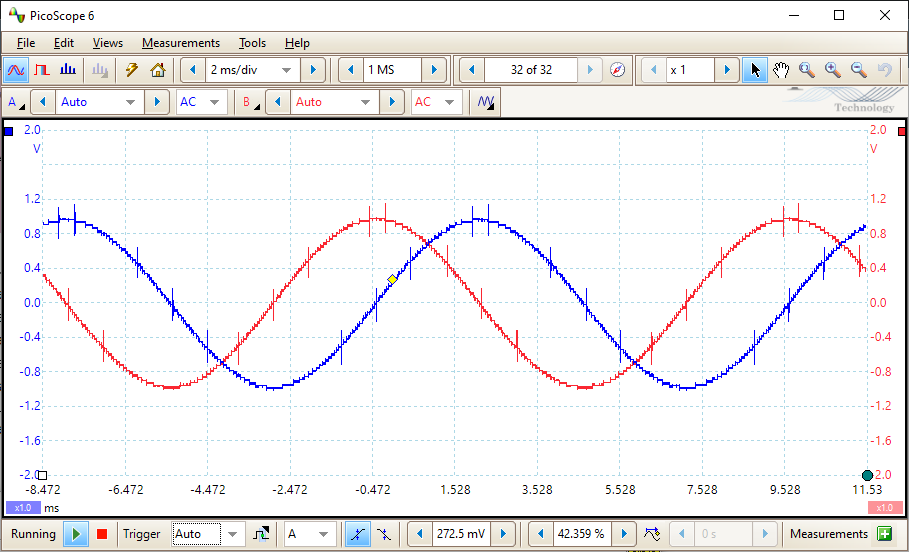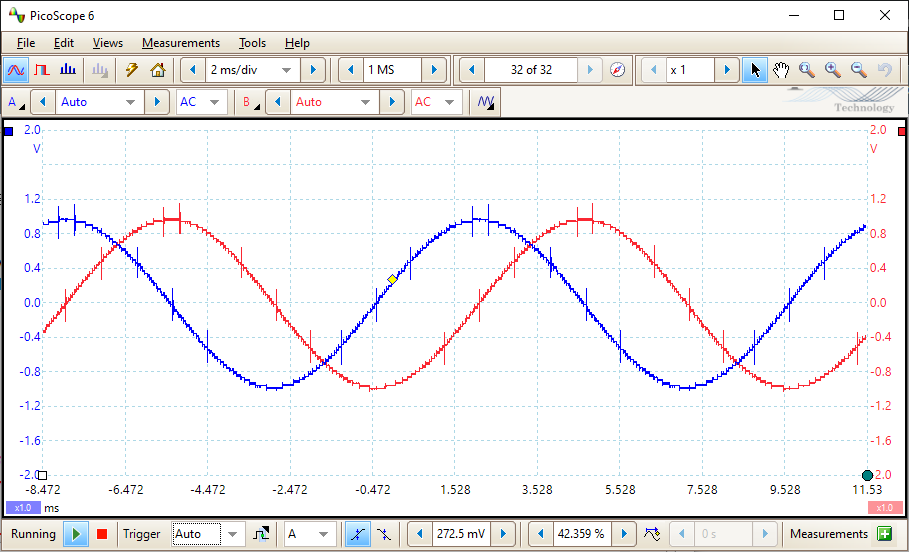1. Introduction
This exercise investigates the relation between complex number and sinusoidal waves. We would define how to convert between sinusoid and magnitude/phase complex number representation, and write a MATLAB program to convert between polar form/rectangular form of complex numbers.
2. Procedures
2.1. Exercise
2.2. Sinusoids as Complex Numbers
2.2.1. Phasor Diagram
Having ARB1 to be and ARB2 to be
.

The sum of ARB1 and ARB2 is 1+j or
.
If change ARB2 to , as in Figure 3, “ARB2
changed phase”, the sum would be 1-j or .

2.2.2. XY View
The XY view of the two channels shows a circle, because the X axis is the voltage of channel A and Y axis corresponds to the voltage of channel B at same time, when channel A is at the peaks the channel B has zero, which is corresponding to X axis at zero.
Showing only channel B would show a straight line on Y axis corresponding to the peak-to-peak amplitude of channel B.
Showing only channel A would show a straight line on X axis.
For ARB1, amplitude is 1, phase of -15 degree, it gives the function .
For ARB2, amplitude is 1.2, phase of 75 degree, it gives the function .
2.3. Complex Numbers and MATLAB
The two functions, pol2rec, and
rec2pol, are implemented so:
|function [z] = pol2rec(x)
|% Polar to rectangular
|r = x(1);
|theta = deg2rad(x(2));
5 |z = r*exp(1i*theta);
|end
|
|function [x] = rec2pol(z)
|% Complex number to polar form
10 |x = [abs(z),rad2deg(phase(z))];
|end
2.4. TIMS and MATLAB Combined
-
ARB1 is .
ARB2 is .
Sum is , computed with
rec2pol(pol2rec([1,-15])+pol2rec([1.2,75])). -
ARB1 is .
ARB2 is .
Sum is .
-
ARB1 is .
ARB2 is .
Sum is . It is easy to observe that is the same as .
2.5. Conjugate Signals
| Phase (degrees) | Output signal amplitude |
|---|---|
| 0 | 2.0 |
| 30 | 1.718 |
| 60 | 1.143 |
| 90 | 0 |
| 120 | 1.125 |
| 150 | 1.723 |
| 180 | 2.0 |
| 210 | 1.723 |
| 240 | 1.143 |
| 270 | 0 |
| 300 | 1.125 |
| 330 | 1.718 |
| 360 | 2.0 |
3. Feedback
This lab shows how to use MATLAB to compute with complex numbers. I think MATLAB is not as handy as a good calculator for this task.
However, since most of are already familiar with the subject on complex number, it might be easier if go straight to the SPF experiment part.